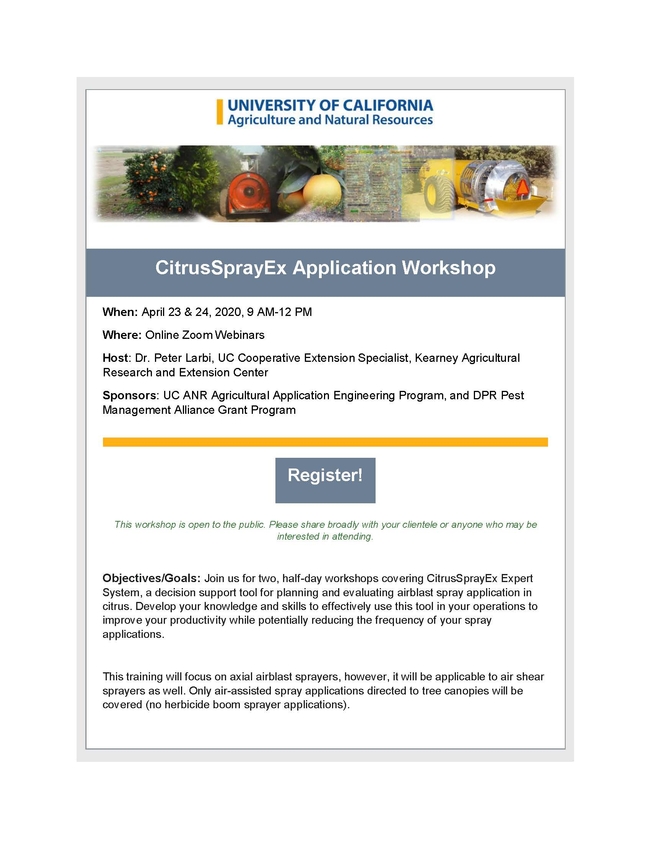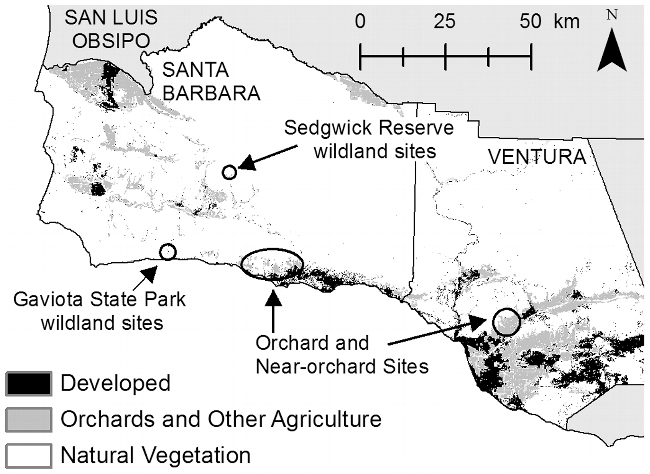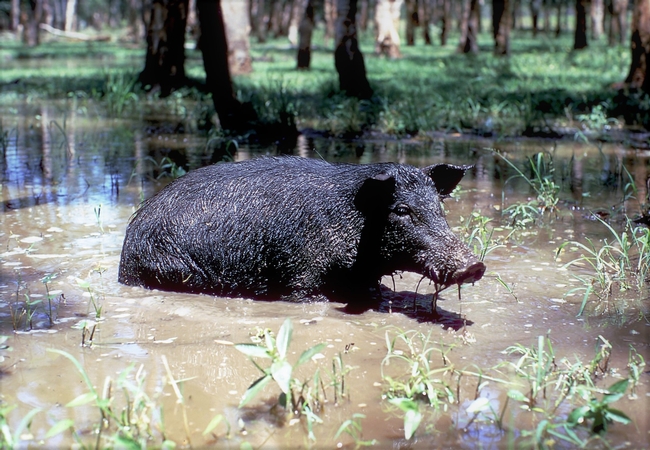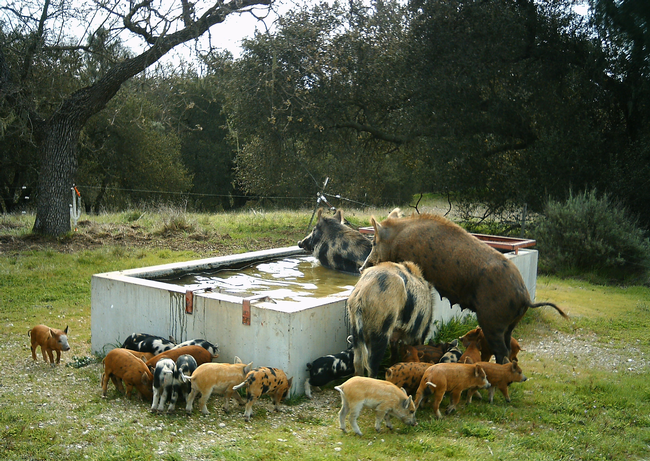
Posts Tagged: orchards
Orchard Spray Webinar
TWO-DAY AGENDA CAN BE FOUND HERE

spray machines
Italian Ryegrass Resistance to Herbicides
WESTMINSTER, Colorado - November 23, 2018 - Herbicides have been instrumental in managing Italian ryegrass, a weed that frequently competes with perennial crops in California. Herbicide-resistant populations have become increasingly commonplace, though, including paraquat-resistant Italian ryegrass found recently in a California prune orchard.
A team of scientists set out to determine if the paraquat-resistant population might also be resistant to other postemergence herbicides. Seven other herbicides commonly used in fruit tree and nut tree crops were included in the study, including clethodim, fluazifop-P-butyl, glufosinate, glyphosate, pyroxsulam, rimsulfuron and sethoxydim.
Researchers found the paraquat-resistant population was also resistant to both clethodim and glyphosate. Among the remaining herbicides, glufosinate, rimsulfuron and sethoxydim were found to deliver the best postemergence control. Unfortunately, though, other populations of Italian ryegrass have developed resistance to the three herbicides, indicating their effectiveness may be short-lived.
"Overreliance on postemergence herbicides from a variety of chemical classes can result in weed populations that exhibit multiple resistances," says Caio Augusto Brunharo, a postdoctoral research fellow at the University of California, Davis. "Effective herbicide-resistance management programs are necessary for sustainable weed control."
The researchers recommended a number of preemergence herbicides as control options for Italian ryegrass in fruit and nut tree crops, including tank mixes containing indaziflam and flumioxazin.
###
Full text of the article, "Multiple Herbicide-Resistant Italian Ryegrass (Lolium multiflorum) in California Perennial Crops: Characterization, Mechanism of Resistance and Chemical Management" is now available in Weed Science Volume 66, Issue 6.
About Weed Science
Weed Science is a journal of the Weed Science Society of America, a nonprofit scientific society focused on weeds and their impact on the environment. The publication presents peer-reviewed original research related to all aspects of weed science, including the biology, ecology, physiology, management and control of weeds. To learn more, visit http://www.

italaian ryefrass resistance
Unlikely Critters Found in Avocado Orchards
Wildlife isn't always restricted to wild spaces.
Avocado orchards and other agricultural landscapes also buzz with species that forage and reproduce in these spaces. Birds and herbivores are able to find food and shelter in these cultivated areas, but what about carnivores? In a study published in PLOS ONE, researchers at the University of Washington have discovered that mammalian carnivores also occupy avocado orchards in southern California.
The authors used motion-activated cameras to observe animals in orchards and in adjacent wild lands in Santa Barbara and Ventura. Avocado orchards were of particular interest due to their location near native vegetation.
Through their investigation, the researchers detected more carnivores in the avocado orchards than in neighboring wild land sites. At least 7 out of the 11 native carnivores in the area were spotted roaming the orchards, including bear, coyotes, gray foxes and bobcats.
Having delicious avocados handy may explain why some omnivores such as bears and raccoons are present in the area, however, little is known about why animals like bobcats and mountain lions might leave their wild habitat for cultivated land. One possibility is that the orchards provide water and fruits for herbivores, and an increased herbivore population could translate to more prey for the carnivores. The orchards may also serve as shelter, offering forest cover similar to oak woodlands in the area.
These native species cannot always persist in protected reserves, so it is important to learn how cultivated lands can serve their lifestyle and behaviors. The carnivores may not be searching for the perfect guacamole ingredient; however there is no doubt that the avocado orchards are serving as a habitat for a wide range of species.
Citation: Nogeire TM, Davis FW, Duggan JM, Crooks KR, Boydston EE (2013) Carnivore Use of Avocado Orchards across an Agricultural-Wildland Gradient. PLoS ONE 8(7): e68025. doi:10.1371/journal.pone.0068025
http://journals.plos.org/plosone/article?id=10.1371/journal.pone.0068025

avocado bear
Wild Pig Management in Citrus
Wild pigs currently exist in 56 of California's 58 counties and can be found in a variety of habitats ranging from woodland, chaparral, meadow, grasslands and in agriculture cropping systems. Wild pigs are commonly found in the foothill areas, and they prefer areas of dense brush, however the drought has led them to encroach into orchards. Wild pigs can cause significant damage to farm and rangelands, natural resources, environmentally sensitive habitats, and property. Wild pig depredation on livestock and poultry can cause high economic loss (Choquenot et. al. 1996). Also, wild pigs can carry a number of diseases and parasites that can be transmitted to livestock, wildlife, and humans. In California, wild pigs can be carriers of Brucellosis, Cholera, Leptospirosis, Tuberculosis (Bovine, Avian, and Swine), Q fever, Trichinosis, Toxoplasmosis, Pseudorabies, and Plague (Barrett and Tietje 1993).
DESCRIPTION OF THE PEST
Domestic swine were imported to the United States by European settlers in the 1700s. Whereas Domestic swine foraged freely, eventually becoming semi-wild, or “feral” (CDFW 2017), California's wild pigs were descendants of the Eurasian wild boar, introduced to Monterey County, California in the 1920s. The physical characteristics of California's wild pigs vary significantly throughout the state. Some exhibit the long hair and snouts, small erect ears and angular shaped bodies of their wild boar ancestors, while others have short hair, long floppy ears, and a barrel-shaped body. Colors range from solid black to red, striped, grizzled or spotted (CDFW 2017). Domestic pigs that are unmarked and roam freely are also considered to be wild pigs.
DAMAGE IN CITRUS
Cultivation operation disruption
Evidence of wild pigs' presence is obvious even if you don't see them physically. Wild pigs use their snouts to root up the ground in search of food, including plant roots, fungus, and other items. Wild pigs are omnivorous, consuming both plant and animal matter. In general, wild pigs feed on: grasses and forbs in the spring; mast and fruits in the summer and fall; and roots, tubers and invertebrates throughout the year.
Wild pigs will feed on insects and underground vegetation. This rooting behavior can disrupt parts of the orchard floors. it could lead to the trees becoming susceptible to root rot diseases that could spread throughout the grove. They are also known to eat fruit off of the lower branch scaffolds. Pigs will contribute to erosion which can affect water quality and also create large uneven basins, or wallows in moist soil during hot weather. Both rooting and wallows can disrupt the application of irrigation water by ruing or displacing irrigation equipment and resulting pools can become breeding habitat for mosquitoes.
Food safety
Wild pigs can also create a food safety issue. Growers are now required to show a Food Safety Good Agricultural Practices for California Citrus Growers (GAPs). This practice is focused on the grower's particular role in providing safe citrus fruits for consumers. The grower should assess the impact of domestic, livestock and wild animal activity for potential pathogen contamination of the grove and fruit. The assessment should include the extent of intrusion, nearness to the grove, proximity to harvest and other relevant factors. Based on the assessment, the grower should put into place measures to exclude domestic animals and minimize the intrusion of wildlife into the grove.
- The grower should monitor the grove and adjacent land for evidence of animal activity and the potential for contamination of fruit or equipment.
- The grower should return bins to packers if there is evidence of contamination.
- When the assessment or monitoring indicates possibility of contamination with pathogens, the grower should take action as needed to minimize potential for contamination of the fruit and to prevent the harvest of any potentially contaminated fruit
Pre-Harvest
- The grower should perform a documented evaluation of the grove environment for changes that may be likely to result in contamination of the citrus fruit with pathogens. Evaluation should include inspection for:
o Evidence of animal intrusion such as downed fences, presence of live or dead animals, animal tracks or animal feces. If animal intrusion is detected, measures shall be taken to remove or prevent from harvest any potentially contaminated product.
o Presence of potentially contaminating materials (e.g. uncomposted manure, etc.) likely to pose a contamination risk to the grove to be harvested.
o Evidence that the irrigation water source and delivery system may potentially be compromised.
For more information regarding Citrus GAP: http://ccqc.org/wp-content/uploads/2009/05/Final-Food-Safety-GAP-document-_Oct-26_.pdf
MANAGEMENTClassified as a game mammal in California, wild pigs provide year-round hunting opportunity and fall under the jurisdiction of the California Department of Fish and Wildlife (CDFW). A hunting license and a tag is required to hunt wild pigs. If wild pigs are causing damage to your property, pigs can be trapped or shot, but this requires a depredation permit. Contact your local CDFW representative for further details on depredation permits (https://www.wildlife.ca.gov/Conservation/Mammals/Wild-Pig/Depredation).
Monitoring and Management Strategies
Fencing
Fencing can be extremely effective but because of costs it can be extremely prohibitive. However, on smaller scales, exclusionary fencing can be an effective option. One of the most effective designs seems to be the installation of sturdy wire mesh fencing. The bottom wire should be either tightly stretched on the ground surface or buried. The addition of an electrified wire about 6 to 8 inches off the ground is also recommended. The fence should be at least 36 inches high. Electric fencing alone has also been shown to restrict the movement of wild pigs also. Poorly designed and constructed fences will significantly increase repair and maintenance time. It is important to carefully consider the costs and benefits of fencing for pig exclusion before embarking on such a venture.
Trapping
Trapping can be an effective method of removing wild pigs from your orchard. The most commonly used traps are box traps and corral traps. Corral traps are much larger than box traps and are designed to capture multiple pigs. It is important to consider that all wild animals can be unpredictable when approaching captured pigs.
In some counties, the agricultural commissioner has trappers who can assist; other counties have contracts with USDA-Wildlife Services to assist with problematic pigs.
Toxicants and Repellents
Currently there is one toxicant registered for use on wild pigs in the United States (EPA Reg. No. 72500). This product is not currently registered for use in California. This product may only be used to control wild pigs on pastures, rangeland, forests, non-crop areas, and crop lands. This bait may only be applied in hog feeders equipped with heavy lids (8 to 10 lbs. of total weight) on bait compartments so as to limit direct access to bait by nontarget animals. This product may be toxic to fish, birds and other wildlife. Dogs and other predatory and scavenging mammals and birds might be poisoned if they feed upon animals that have eaten the bait. Wild pigs must be conditioned to accept feed from the bait dispensers and to open the weighted lids to bait compartments.
Repellents are not generally considered effective against many mammalian pests and this is also true for the management of wild pigs.
Collecting information on wild pig damage
UCANR is asking California growers and landowners to help keep track of the state's wild pigs and the damage they are causing through a new Wild Pig App. The app is available for download on Apple and Android devices and will collect information on wild pig damage throughout California. Cell service at the site of pig damage is also not required to collect the information. The information collected will be used by University of California Cooperative Extension Specialists and Advisors to learn more about wild pigs in the State.
Download the app at your App Store to participate in the wild pig damage project without the app, landowners and growers can fill out a short survey at http://ucanr.edu/wildpig2016.
Additional Resources
Barrett, R. H. and G. H. Birmingham. 1994. Wild Pigs. The Handbook: Prevention and control of wildlife damage. Cooperative Extension Division, University of Nebraska-Lincoln.
California Department of Fish and Wildlife <https://www.wildlife.ca.gov/Conservation/Mammals/Wild-Pig> Accessed: 24 July 2017.
Barrett, R. H., and W. Tietje. 1993. The wild pig in California oak woodland: ecology and economics. Conference Presentation Summaries. Univ. of California, Berkeley.
Coping with Feral Hogs. Texas A&M AgriLife Extension Service.
Feral Hog Biology, Impacts, and Eradication Techniques (PDF). 2010. USDA APHIS Wildlife Services New Mexico.
Finzel, J. A. and Baldwin, R. A., (2015) Pest Notes: Wild Pigs. UC ANR Publication 74170
Hamrick, B., M. D. Smith, C. Jaworowski, B. Strickland. 2011. A Landowner's Guide for Wild Pig Management(PDF). Publication 2659.
Jay-Russell, M. T., A. Bates, L. Harden, W. G. Miller, and R. E. Mandrell. 2012. Isolation of campylobacter from feral swine (Sus scrofa) on the ranch associated with the 2006 Escherichia coli O157:H7 spinach outbreak investigation in California. Zoonoses and Public Health. 59:314-319.
Kreith, M. 2007. Wild pigs in California: the issues (PDF). AIC Issues Brief No. 33. Agricultural Issues Center, University of California.
Sweitzer, R. A. and D. H. VanVuren. 2002. Rooting and foraging effects of wild pigs on tree regeneration and acorn survival in California's oak woodland ecosystems (PDF). USDA Forest Service General Technical Report PSW-GTR-184.
Waithman, J. 2001. Guide to hunting wild pigs in California. California Department of Fish and Wildlife, Wildlife Programs Branch.
West, B.C., A. L. Cooper, J. B. Armstrong. 2009. Managing wild pigs: A technical guide (PDF). Human-Wildlife Interactions Monograph 1:1.
Which Way Mulch in Ag?
7:00 A.M. Check In and Breakfast Buffet
8:00 A.M. Welcome
8:10 A.M. Opening Keynote - Our Organic Resources
Evan Johnson, Science and Policy Advisor, CalRecycle
Biomass Sources and Concerns
8:30 A.M. The Agricultural Perspective
Moderator: Ben Faber, Ph.D., Farm Advisor,
UC Cooperative Extension-Ventura and Santa Barbara Counties
Presentation: Introduction to the Agricultural Perspective
Robert Atkins
ACP/HLB Statewide Coordinator;
California Invasive Species Advisory Committee Past Chair;
Retired San Diego County Agricultural Commissioner
Panel Discussion:
Eric Larson, Executive Director, San Diego County Farm Bureau
Duane Schnabel, Branch Chief, Pest Exclusion Branch,
California Department of Food and Agriculture
Tim Spann, Research Program Director, California Avocado Commission
Dr. Jerrold Turney, Pathologist, County of Los Angeles,
Department of the Agricultural Commissioner/Weights and Measures
9:30 A.M. The Rural and Natural Landscapes Perspective
Moderator: Sabrina Drill, Ph.D., Natural Resources Advisor,
UC Cooperative Extension - Los Angeles and Ventura Counties
Presentation: Introduction to the Rural and Natural Landscapes Perspective
Sheri Smith
Regional Entomologist, USDA Forest Service, Region 5
Panel Discussion:
Paul Noring, President, Main Street Materials, Inc.
Michael Puzzo, Environmental Scientist, California State Parks-Colorado Desert District
Kevin Turner, Invasive Pests Program Coordinator/Forester, CA Department of Forestry and Fire Protection (CAL FIRE)
10:30 A.M. Break
11:00 A.M. The Urban Landscapes Perspective
Moderator: Jennifer Pelham, Environmental Horticulture Advisor,
UC Cooperative Extension-Orange and San Diego Counties
Presentation: Introduction to the Urban Landscapes Perspective
John Kabashima
Advisor Emeritus, University of California Cooperative Extension
Panel Discussion:
Richard Demerjian, Assistant Vice Chancellor, Environmental Planning and Sustainability, University of California, Irvine
Andy Trotter, Vice President-Field Operations, West Coast Arborists, Inc.
Roc White, Manager, Viramontes Express Mobile Grinding
12:00 P.M. Lunch
Environmental and Regulatory Issues
Moderator: Kevin Turner Invasive Pests Program Coordinator/Forester,
CA Department of Forestry and Fire Protection (CAL FIRE)
1:00 P.M. Julee Malinowski-Ball, Public Policy Advocates, LLC
1:20 P.M. Woody chips as landscape mulch in fire-prone areas
Pam Padgett, Pacific Southwest Research Station, USDA Forest Service
1:40 P.M. Developing a Regional Biomass Management Strategy: Balancing Multiple Interests
Michael Wonsidler, Coordinator, Solid Waste Planning and Recycling,
County of San Diego Department of Public Works
Biomass Utilization Methods
Moderator: Tracy Ellis, Entomologist, County of San Diego,
Department of Agriculture, Weights and Measures
2:00 P.M. Wood and Biomass Utilization Overview
Larry Swan, Wood & Biomass Utilization Specialist, USDA Forest Service, Region 5
2:20 P.M. Composting
David Crohn, Extension Resource Conservation Specialist, UC Riverside
2:40 P.M. Air Burners
Michael O'Connor, Director, North America Sales Division, Air Burner, Inc.
3:00 P.M. Break
3:20 P.M. Panel: Potential Solutions and Associated Economics
Moderator - Stephen Kaffka, Extension Agronomist, UC Davis; Director, California Biomass Collaborative
4:20 P.M. Closing Keynote
Thom Porter, Chief, Southern California Region, CA Department of Forestry and Fire Protection (CAL FIRE)
4:40 P.M. Closing Comments and Evaluation
5:00 P.M. Adjourn
Presentation and Panel Speakers
Evan Johnson, Science and Policy Advisor, CalRecycle
Thom Porter, Chief, Southern California Region, CAL FIRE
Robert Atkins, California Invasive Species Advisory Committee Past Chair, Retired San Diego Agricultural Commissioner
Sheri Smith, Regional Entomologist, Region 5, USDA Forest Service
John Kabashima, Environmental Horticulture Advisor, Emeritus,
UC Cooperative Extension
Julee Malinowski-Ball, Public Policy Advocates, LLC
Pam Padgett, Pacific Southwest Research Station, USDA Forest Service
Michael Wonsidler, Coordinator, Solid Waste Planning and Recycling,
County of San Diego Department of Public Works
Larry Swan, Wood & Biomass Utilization Specialist, USDA Forest Service, Region 5
David Crohn, Extension Resource Conservation Specialist, UC Riverside
Michael O'Connor, Director, North American Sales Division, Air Burners, Inc.
Stephen Kaffka, Extension Agronomist, UC Davis and
Director, California Biomass Collaborative
Tim Spann, Research Program Director, California Avocado Commission
Eric Larson, Executive Director, San Diego County Farm Bureau
Michael Puzzo, Environmental Scientist, CA State Parks-Colorado Desert District
Kevin Turner, Invasive Pests Program Coordinator/Forester,
CA Department of Forestry and Fire Protection (CAL FIRE)
Richard Demerjian, Assistant Vice Chancellor,
Environmental Planning and Sustainability, University of California, Irvine
Andy Trotter, Vice President-Field Operations, West Coast Arborists, Inc.
Roc White, Manager, Viramontes Express Mobile Grinding
Duane Schnabel, Branch Chief, Pest Exclusion Branch,
California Department of Food and Agriculture
Dr. Jerrold Turney, Pathologist, County of Los Angeles,
Department of the Agricultural Commissioner/Weights and Measures
Paul Noring, President, Main Street Materials, Inc.

green waste






